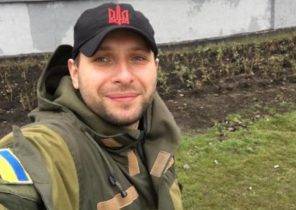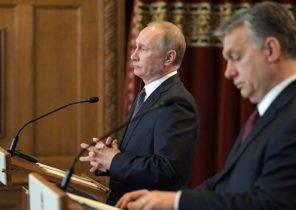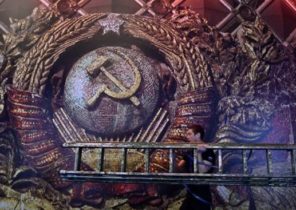It is wrong to call all Soviet soldiers who fought in the Second world war, the Russian. Here is the story of a few soldiers who found their final resting place in the cemetery in Bergen.
On a small grassy hill in the cemetery Gradespeed in Bergen, you can see a small plate with the inscription “Sabaev” both Latin and Cyrillic. Near similar plate with the inscription “tune”.
There are dozens of such graves without decorations and ornaments, without a date of birth and date of death. Most of them only have names: “Shevchenko”, “Ovchinnikov”… some listed the names with the titles.
Among the tombstones — a pole with a red star and a sign: “Soviet prisoners of war who were tortured and executed Hitler’s Nazis”.
There are just some of the Soviet POWs, killed by Germans in Norway during the Second world war.
A nightmare
Sanji Sabev was born in 1916 in the village of Barguzin in the area East of lake Baikal is 400 kilometers to the North from the Russian border with Mongolia. He was of Buryat — Mongolian people, mainly professing Buddhism.
In 1941, he passed military service in the artillery regiment of the Soviet army in the West of the Soviet Union. It was there that he caught the attack of Nazi Germany on 22 June. The Soviet defense was not ready to attack, and the Germans advanced quickly inland. July 4, 1941 Sabeev was captured, and many hundreds of thousands of other Soviet soldiers in the first weeks of the war.
The first time was a real nightmare for prisoners of war. They were locked in camps, sometimes representing nothing more than a bare piece of land surrounded by barbed wire. In the first eight months, some 2 million people died of hunger, cold, exhaustion or as a result of mass executions, whose victims were first and foremost were the Jews, Communists and representatives of other for those or other signs of “undesirable” groups.
But Zabaev all the chaos endured, and after some time arrived (on foot or in the wagon without Windows) in the prison camp Stalag 302 in gross-born in Pomerania, near the former German-Polish border.
From the Ukrainian coast in Listadmin
Alexei Dudka was a native of the seaside village Lozanivka in the South of Ukraine. In October 1941, after three and a half months after the German invasion of the territory of the Soviet Union, it is the ordinary red Army, was taken prisoner in his native Zaporizhia region. He went through a terrible first winter, and then was taken to Stalag II B in Hammerstein — another major camp in Pomerania.
Here he was at the moment when the Germans decided that the Soviet prisoners of war it is better not to kill anyway, and used as labour until they still a glimmer of life.
During the war about 100 thousand Soviet POWs were sent to Norway as slaves. In August 1942, the tune was in Stalag 303 in Lorstadine North of Lillehammer, which was the center of the system of the German camps in the South of Norway.
The camp was a distribution point, and a few weeks later the tune got from there to Bergen. Zabaev arrived from Germany in Jostedalen in September of the same year. He was sent to Bergen a month after the Horns.
Died of a skin disease
The conditions of life of Soviet prisoners in the different camps vary greatly. In some areas of Finnmark have died many, especially in the winter. The mortality rate was extremely high and during the construction of the railway in Nordland.
In southern Norway the camp was less as the number of dead, but there people aren’t treated cruelly. Not without executions. In addition, the prisoners suffered from disease and General exhaustion. Alexey tune of about six months was a slave in Bergen, before falling sick with a skin disease which became fatal for him. March 24, 1943, he died at the age of 34, becoming one of the estimated hundreds of Soviet prisoners of war who died in Bergen.
Sabaevo managed to survive more than three years. But on October 4, 1944 was a big air RAID on German base submarines in Laksevag. During the bombing killed 193 civilian, including dozens of students at the school is Sleek. Thirteen Soviet prisoners of war were also among the victims, including 27-year-old Sandi Zabaeva, which is now buried in Bergen, 6 thousands of miles from home.
Zabaev and tune — only two of the approximately 13 thousand Soviet soldiers who died in captivity in Norway.
Military history as a method of propaganda
During the war and long after it, Soviet prisoners of war were called “Russian”. This is not surprising because the name “Soviet Union” appeared only in 1922, and the word “Russia” has existed for a long time and felt quite natural. And now the Soviet Union for 30 years.
The current Russian government is actively using military history for propaganda purposes, putting an equal sign between the Soviet Union, who fought, suffered and in the end won the Second world war, and modern Russia. This raises questions, especially given the current conflict between Russia and Ukraine, the largest former Soviet republics, excluding Russia itself. Ukraine, Belarus and many other countries participated in the Second world war as part of the USSR, and the soldiers there made up a significant part of the red Army. They endured all the hardships of war as well as Russian.
The names of many of the approximately 13 thousand Soviet prisoners of war who died in Norway, not known, but the other was identified. Fallstudie center, which owns the site krigsgraver.no (“war graves”), did a great job to make this information available to the public. Using data and material from the same Russian site you can find many details about those who died in the war, like Sanji Sabaevo and Alex Fife.
It is important to remember that the soldiers were from all over the Soviet Union
These data give an idea about the origin of the soldiers of the red Army. Was able to identify homes 1 152 Soviet prisoners died in the camps of Finnmark. Of these, 74% were from Russia, 19% — from Ukraine, 3% from Belarus and Kazakhstan, and the rest from other Soviet republics, for example, in the Caucasus and Central Asia.
On the territory of the present County of Westland the dead were only 102 people. A maximum of 51 (exactly half) came from Russia as Zabaev. 48 person — and nearly as many were from the Ukraine, as a tune.
Russia was the largest among the Soviet republics, and, of course, most of the soldiers were originally from there, but still wrong to call all Soviet soldiers Russian. Now, when modern Soviet Russia uses military history to improve its reputation, it is important to remember that the Soviet soldiers were from all over the former Soviet Union.
Russians and Ukrainians lie side by side in the graves in the cemetery Gradespeed in Hetta and other places of Norway. We are grateful to the soldiers who fought for the victory that brought freedom and Norway, but our gratitude is addressed not only to Russia but also Ukraine, Belarus, Kazakhstan and other former Soviet republics.







